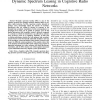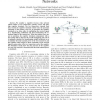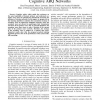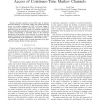ICASSP
2011
IEEE
13 years 1 months ago
2011
IEEE
Efficient design of cognitive radio networks calls for secondary users implementing adaptive resource allocation, which requires knowledge of the channel state information in ord...
TWC
2010
13 years 4 months ago
2010
Abstract--This letter analyzes the impact, from a networklayer perspective, of having a single cognitive radio transmitterreceiver pair share the spectrum with multiple primary use...
TWC
2010
13 years 4 months ago
2010
Dynamic spectrum leasing (DSL) is one of the schemes proposed for dynamic spectrum sharing (DSS) in cognitive radio networks. In DSL, spectrum owners, denoted as primary users, dyn...
JSAC
2011
13 years 4 months ago
2011
Abstract—The problem of cognitive access of channels of primary users by a secondary user is considered. The transmissions of primary users are modeled as independent continuous-...
CORR
2010
Springer
2010
Springer
Binary is Good: A Binary Inference Framework for Primary User Separation in Cognitive Radio Networks
13 years 6 months ago
Primary users (PU) separation concerns with the issues of distinguishing and characterizing primary users in cognitive radio (CR) networks. We argue the need for PU separation in t...
PIMRC
2010
IEEE
13 years 7 months ago
2010
IEEE
We consider a cognitive two-way relay network which consists of two transceivers (primary users) and multiple cognitive terminals. The two transceivers transmit their data toward t...
GLOBECOM
2010
IEEE
13 years 7 months ago
2010
IEEE
Cognitive radios, which enable the coexistence on the same bandwidth of licensed primary and unlicensed secondary users, have the potential for dramatically increasing the efficien...
WIOPT
2010
IEEE
13 years 7 months ago
2010
IEEE
—Cognitive radio networks provide the capability to share the wireless channel with licensed (primary) users in an opportunistic manner. Primary users have a license to operate i...
WCNC
2010
IEEE
13 years 7 months ago
2010
IEEE
—Dynamic spectrum access (DSA) aims to improve spectrum efficiency via spectrum sensing and optimal spectrum access. An essential component in DSA is the joint design of sensing...
TWC
2008
13 years 9 months ago
2008
A resource allocation framework is presented for spectrum underlay in cognitive radio networks. We consider both interference constraints for primary users and quality of service (...




